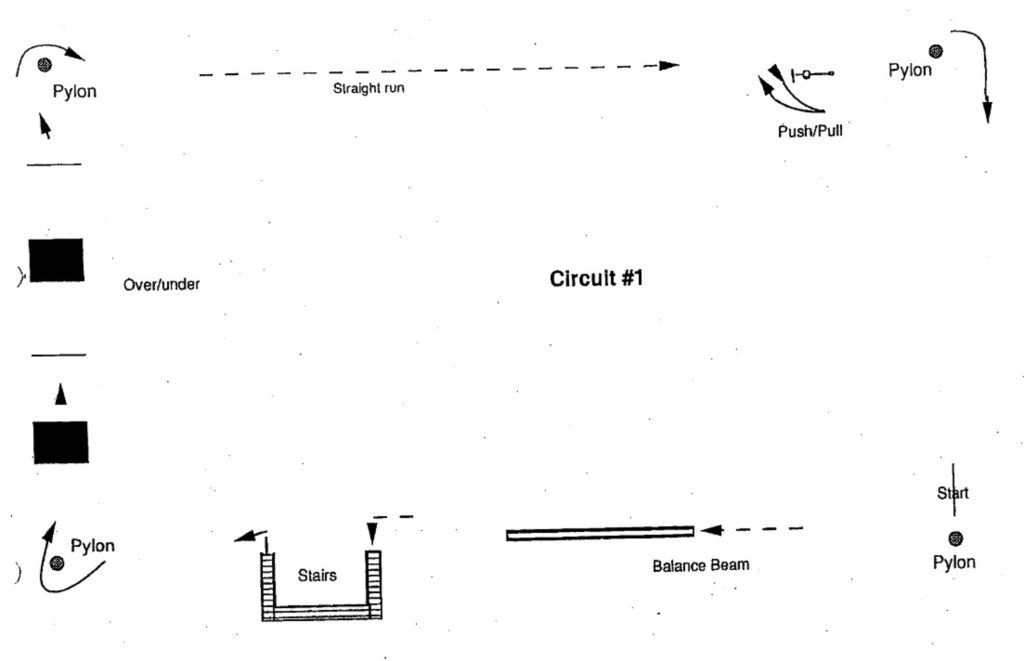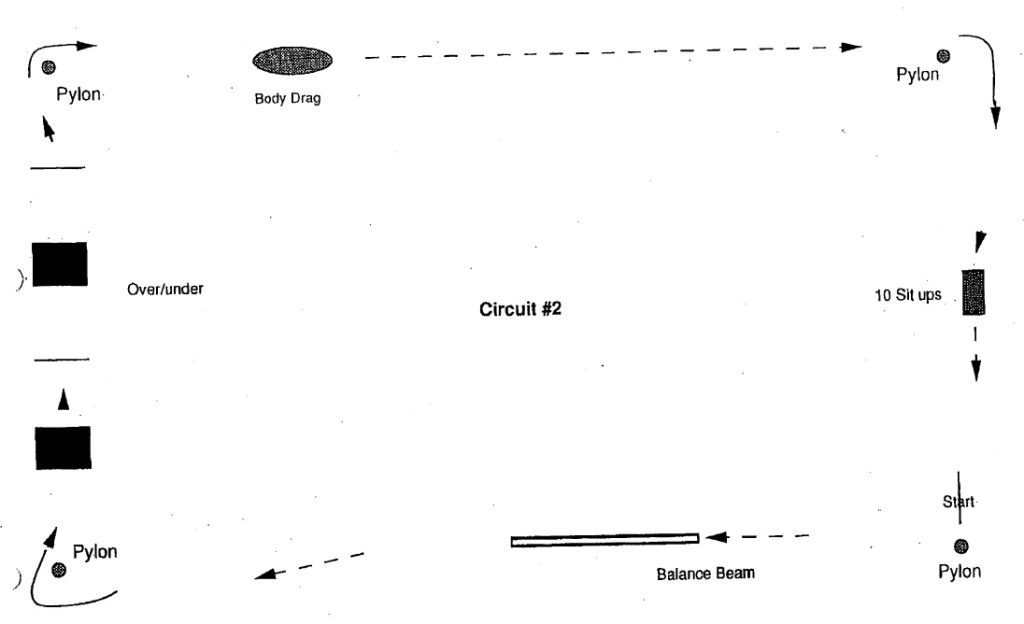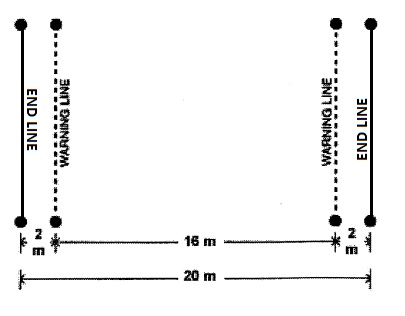Chapter 1 – Introduction to Fitness for Paramedics
PARA Fitness Test Descriptions
1. Paramedic Evaluation Test (PET)
The following PET description has been copied directly from the City of Greater Sudbury’s Paramedic Services and modified to reflect Cambrian College’s testing environment.
The PET circuit is a series of job performance physical ability tests that simulate the most common daily physical demands of Emergency Medical Services (EMS) work. The test involves a three-cycle obstacle course, identifying four typical physical labour tasks that paramedics must perform on a daily basis, including strength, agility, anaerobic capacity, and flexibility.
The physical aspects of EMS work can be described by these four physical activities and are considered crucial, essential and critical. The PET circuit must be successfully completed within a standardized pre-determined time.
In each cycle of the obstacle course, at least two of the above physical labour tasks are challenged. Aspects of the test duplicate a scenario where a paramedic must (a) get to the patient, (b) physically attend to the patient, and (c) remove the patient. As the level of performance demanded varies per situation, the test is practical and deemed to be both realistic and reasonable.
Stations
- Obstacle Course – Mobility Run: The PET circuit consists of an approximately 300m (984 ft) obstacle run where the student must demonstrate gross motor abilities such as mobility, agility, flexibility, power, and general aerobic endurance.
- Strength Station: The strength station consists of a pull unit where the student must suspend a 50lb (23kg) weight off the ground and travel through four 180-degree arcs, keeping the weight elevated during the entire exercise.
- Body Drag: The body drag session of the PET circuit requires the student to drag an approximate 90lb mannequin over a distance of 30m (100ft). A hose/sled weighted to 90lb may be used to stimulate the dummy. In Cambrian’s Paramedic program, a 90lb sled is used.
Description of the PET
The PET consists of three cycles/laps at a controlled time pace. The first cycle consists of an approximately 100m obstacle run where the student must demonstrate gross motor abilities such as agility, flexibility, and general endurance. Further details on grade attribution (e.g., the weight of this test or what time needs to be achieved to obtain passing grades) can be found in the next section of the textbook. The PET is laid out in the following manner (see images after cycle descriptions).
Lap 1 and Lap 3:
- Starting from the start marker pylon, the student runs straight ahead to the first obstacle – the balance beam. The balance beam must be crossed lengthwise. If a foot touches the floor, the student must go back to the beginning of the beam.
- From the balance beam, the student runs forward to the second marker and proceeds up and down the staircase twice.
- From the stairs, the student runs forward to the end of the gym around the last pylon to the outside and faces the over/under components. The student must go over the first obstacle (pommel horse), go fully under the second obstacle (low bar), go over the third obstacle (pommel horse), and go fully under the last obstacle (low bar). When going over the pommel horse, the entire body must travel over the top of the obstacle (i.e., cannot swing legs over the side). Failure to maintain proper form could lead to going back to complete the obstacle again. If any of the bars are knocked off, the student is penalized five seconds per bar.
- Upon exiting the over/under component, the student proceeds forward around the outside of the next marker and continues forward in a straight run to the pull component. Upon reaching the pull unit, the student grasps the rope and pulls the weight (50lb/23kg) off the floor. Maintaining the weight in this position (elbows are to be flexed), the student moves through four arcs of 180 degrees. The weight is then lowered in a controlled manner to the floor. In order to maintain balance, a shuffle movement of the feet is suggested, the back should be kept straight while the abdominal muscle contract, thus stabilizing the pelvis. For every occurrence of the weight touching the floor, an additional penalty arc is given.
- From the pull unit, the student goes outside of the next marker and returns to the starting line, completing the first cycle/lap.

Lap 2:
- From the start marker, the student runs to the balance beam as in Lap 1.
- After the balance beam, the student runs forward to the end of the gym, bypassing the stairs, and turns around the last pylon to face the over/under components.
- The student completes the over/under components as in Lap 1.
- After the over/under components, the student proceeds forward, runs around the outside of the next marker, and returns to the body drag (located next to the outside marker). In a safe and controlled manner, the student must drag the 90lb sled along the gym floor for a distance of 30m (100ft), moving backwards throughout. Once completed, they proceed to the mat for the sit-up component.
- At the floor mat, the student lies flat on their back with knees at a 90-degree angle and performs, or at least attempts, ten consecutive, controlled sit-ups. The feet must remain on the floor, and the wrists must pass the knees on each contraction. Upon completing ten sit-ups, the student gets up and proceeds to the start pylon.

Lap 3:
Reminder that Lap 3 is identical to Lap 1, with the start line becoming the finish line.
PET test summary:
Lap 1 and Lap 3:
- Start
- Balance Beam
- Stairs (2x)
- Marker
- Over/Under
- Marker
- Straight Run
- Pull Station
- Marker / Start / Finish line
Lap 2:
- Start
- Balance Beam
- Straight Run (no stairs)
- Marker
- Over/Under
- Marker
- Body Drag (with sled)
- Sit-ups
- Marker/Start line
Common Faults:
- Stepping off the balance beam
- Failing to clear the Over/Under stations fully
- Failing to run around the outside of the pylons/markers
- Failing to maintain the weights off the floor at the pull station
- Not maintaining proper technique in the sit-ups
In each case if a common fault occurs, the student is asked to re-do the portion of the test or replace the knocked down item and is assessed a penalty.
2. Shuttle Run (Beep Test)
The Shuttle Run, also known as the Leger 20m Shuttle Run or Beep Test, evaluates the student’s aerobic fitness or work capability for physically demanding tasks on the job as well as everyday paramedic activities. In this test, the student runs back and forth between two marked lines over a 20m distance in time with an audio track (producing “beeps” as cues). The time permitted to cover the 20m at the beginning of the test requires a slow jog. As the test’s stages progress, the time between the beeps shortens, requiring the student to run faster to keep up with the audio track’s cues. The audio track will also inform the student which stage they have reached as the test progresses.
In each leg of the Shuttle Run, warning lines (placed 2m before each of the 20m end lines) must be reached before the permitted time elapses and the beep is heard. If the student fails to cross the warning line before the beep, the test will be terminated (the professor may choose to provide a warning if the student is clearly learning the pace of the beeps). If the student crosses the warning line but fails to reach the end line before the beep, the professor will give the student a warning, and they must still reach the end line before returning to the other end line. If the student receives a warning but reaches the following end line before the next beep, the warnings are reset to zero. However, if the student receives two consecutive warnings (i.e., the student crosses the warning line but does not reach the end line before the beep), the test will be terminated. The test can also be terminated if the student chooses to stop.
For best performance, it is crucial that students learn to run at the pace of the audio track. Running quickly in the early stages of the test to get a longer “break” at the end lines typically leads to worse performance. This is because their heart rate is slowly increasing to meet the exercise demand, yet the “breaks” keep initiating recovery and lowering it, leading the heart to constantly be playing catch up and creating a greater anaerobic response than required. The aim should be to reach the end lines exactly when the beep is heard.
In the Cambrian College Paramedic program, the Shuttle Run will be completed as a group, no more than 10 minutes after the last student has performed the PET Test. In other words, students will perform the PET test, and 10 minutes after the last student has completed their PET Test, the entire group will complete the Shuttle Run together. Further details on grade attribution (e.g., weight of this test, or which stage to reach to obtain passing grades) can be found in the next section of the textbook.

3. Stair Chair and Stretcher Carry
The Stair Chair and Stretcher Carry test evaluates the student’s muscular strength, endurance, and cardiorespiratory endurance, as well as their ability to communicate and coordinate their efforts with a partner. For both tests, the emphasis is placed on proper lifting technique and patient safety, and require the pair of students to complete each component in six minutes or less. The following describes the test along with test termination criteria, but further marking rubrics can be found in the next section of this textbook.
For the Stair Chair, the pair of students will carry a stairchair with a weighted manikin up and down four flights of stairs within six minutes and are permitted to place the stairchair down on the landings without penalty. Students may set-down the stairchair outside of the landings (no more than twice) but will incur a penalty on their marking rubric as a consequence. Students can choose who begins at the head/foot position of the stairchair but will switch positions halfway up. They can also choose starting positions upon descending but will again switch positions halfway down. For the Stretcher Carry (also known as Scoop), pairs of students will safely demonstrate the ability to lift a weighted manikin secured to a scoop stretcher and carry them up/down one flight of stairs, secure to 35, transport to an ambulance where the patient will be safely loaded and secured, then unloaded and returned to the starting position. Students may choose who lifts at each end but will remain at that end throughout the test. Students will have six minutes to complete this task.
Termination Criteria due to Unsafe Critical Errors
If the following errors are committed, the test will be terminated at the faculty’s discretion due to safety concerns (i.e., preventing an injury), unsuccessful performance, etc.
- Gross unprofessionalism, such as profanity, disrespect, emotional display unbecoming of a paramedic, gross negligence of equipment use, etc.
- More than two controlled set-downs outside of the landings (i.e., in the flight of stairs). Two or less controlled set-downs will lead to mark deductions.
- Action causing patient harm (i.e., dropping a chair in an uncontrolled manner, tipped over, patient head striking wall or railing, carried head down, etc.)
- Delay causing patient harm – either test exceeds six minutes.
- Required spotter to maintain balance, prevent fall, or assist in any manner. This can include excessive use of a wall or railing for support.
Click the link for more information on the Greater Sudbury Paramedic PET, last updated 2019.

